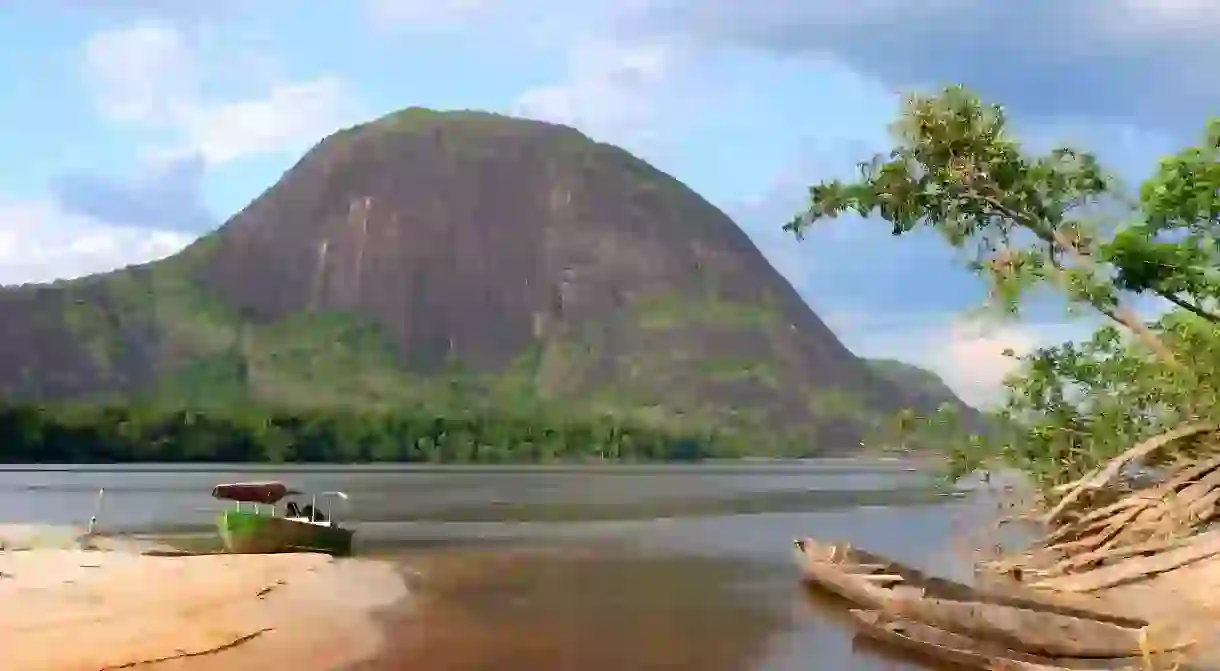11 Surreal Colombian Destinations You Need to Visit at Least Once

Colombia is jampacked with stunning and surreal destinations. The country is home to five totally distinct ecosystems – the Andes, Amazon, Orinoquia, Caribbean, and Pacific – and each of these unique regions is home to some bizarre and beautiful places. From ancient rock paintings daubed on the side of jungle hills to rolling sand dunes tumbling into the Caribbean Sea, here are 11 surreal Colombian destinations.
Cerro Azul, Guaviare
The Guaviare region, on the frontier of the Eastern Plains and the Amazon rainforest, is only just opening up to tourism, but what it’s offering is incredible. One of the highlights of any visit to Guaviare is the chance to visit Cerro Azul, an isolated rocky massif surrounded by hundreds of miles of jungle; on a huge cliff face on the hill are painted hundreds of ancient rock paintings, drawn there by indigenous cultures thousands of years ago and depicting animals, people and geometric shapes. It’s like an open-air jungle museum.

Quebrada Las Gachas, Santander
This red river flowing through the mountains of Santander region is one of the country’s newest tourist attractions, but is fast becoming a must-visit spot for travellers in search of something beautiful and unique. A small creek of crystal-clear water running across red rocks, the river appears to be bright red, and the contrast against the blue skies and green hills of Santander makes for a truly surreal image.
Tuparro National Park, Vichada
One of Colombia’s largest and most overlooked national parks is the magnificent El Tuparro National Park, located on the Orinoco River and on the eastern border with Venezuela. Home to the incredible Maipures Rapids, dubbed the eighth wonder of the world by the naturalist Alexander Von Humboldt, as well as ancient rocky hills, indigenous villages and vast grassland savannahs, Tuparro is like Colombia’s very own Lost World.

Caño Cristales, Meta
Colombia’s most famous red river – and it’s pretty amazing that the country has enough red rivers for there to be a most famous one! – is the iconic Caño Cristales, located in the Macarena National Park in Meta department. The shockingly bright-red colour of the river is caused by a rare and endemic algae which blooms in the waters of the region between June and November; a visit to Caño Cristales is practically guaranteed to impress.
Punta Gallinas, Guajira
The northern deserts of La Guajira region are perhaps one of the most surreal regions of the country: a vast desert, interspersed with colourful salt lakes and bright pink flamingos, all of it framed by the sparkling blue waters of the Caribbean Sea. Within La Guajira, Punta Gallinas, the most northerly point in South America, is delightfully unique and surreal, as giant sand dunes and turquoise bays compete for visitors’ attention with Colombia’s most breathtaking sunsets.

Las Lajas, Nariño
Regularly voted one of the most beautiful churches in the world, the Las Lajas Sanctuary, located right on the border with Ecuador near the town of Ipiales, is a gorgeous gothic revival church constructed over a canyon in the southern Andes. The church rises over 100 metres (328 feet) from the base of the canyon and is connected to the other side by a 50-metre (164-foot) bridge. It’s like something out of a fairy tale, and is easily Colombia’s most impressive and unique church.

Sierra Nevada de Santa Marta
The Sierra Nevada de Santa Marta mountain range is one of the most unique and irreplaceable ecosystems on the planet: an isolated mountain range which predates the Andes, which encompasses practically every ecosystem on planet earth, from coral reefs to glaciers, and is home to some of the highest concentration of endemic species to be found anywhere on the planet. The highest point of the range rises to an altitude of 5,700 metres (3.5 miles) just 42 kilometres (26 miles) from the Caribbean coast, making it the world’s highest coastal mountain range.
Mavecure Hills, Guainia
These three hills in the depths of the jungle of Guainia department, located on the eastern border with Venezuela, are perhaps the most beautiful natural feature in Colombia, and hardly anyone has heard of them. Part of the ancient rocks of the Guiana Shield – some of the oldest rocks on the planet – the Mavecure Hills tower over the surrounding jungle, and climbing them at dawn to watch the sun rise over the forest is a unique and wonderful experience.

Gorgona Island
A jungle-covered island in the Colombian Pacific which used to be a maximum security prison for Colombia’s worst offenders is named after its ridiculously high number of poisonous snakes (after the snake-headed Gorgon of Greek myth) and is now an astonishingly biodiverse paradise for ecotourism: welcome to Gorgona Island. A visit here is a surreal experience: you can be diving with whale sharks and humpback whales one day, and exploring the ruins of a prison in the jungle the next.
El Raudal de Jirijirimo, Vaupes
One of Colombia’s most mysterious and little-known places, the waterfalls of Jirijirimo are located deep in the Amazonian south of Vaupes department and are often described as the most beautiful waterfalls in all of Colombia. The giant Apaporis River narrows at this point and then drops over a 25-metre (82-foot) cascade, and the thunderous tumult is a cacophony of noise and chaos. Trips to the majestic waterfalls also include visits to local indigenous communities and the surreal Apaporis Tunnel, where the river squeezes through an incredibly narrow gap.
The Cocora Valley, Quindio
One of Colombia’s most popular and visited destinations is Salento and the nearby Cocora Valley, and with good reason: the giant wax palms of the Cocora Valley – the tallest in the world at up to 60 metres (197 feet) high – stand like sentinels against the green mountains of the Coffee Region, and wandering among them is a unique and surreal travel experience in Colombia.













